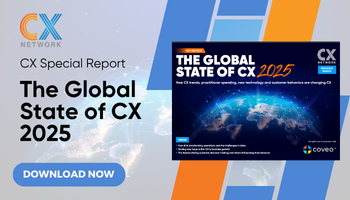A guide to making the most out of customer insights
Learn from an expert about how to leverage artificial intelligence to identify customer insights that you can act on to improve CX
Add bookmark
CX Network’s Global State of CX 2025 report found that 42 percent of practitioners expect spending in customer insights, data and analytics to increase in 2025, and the category tied for sixth place in the list of top 10 investment priorities for practitioners in 2025.

Don't miss any news, updates or insider tips from CX Network by getting them delivered to your inbox. Sign up to our newsletter and join our community of experts.
This makes sense. Customer experience (CX) as a function is increasingly being used more strategically by the most mature organizations because they are taking advantage of technological advancements in artificial intelligence (AI) to analyze the huge array of unstructured customer and consumer feedback, now available via channels such as social media and online reviews. This provides more nuanced data than more traditional CX metrics such as net promoter score (NPS) or customer satisfaction (CSAT) scores. AI and LLMs specifically, however, must be used with caution to ensure accuracy.
To dig into recent developments, and emerging trends, in the field of CX and insights, CX Network sat down with Simon Fraser, vice president of insights and consultancy at InMoment.
CX Network: How did you get interested in customer insights?
SF: My career began in market research at a company called NOP, which then became part of GfK. At the time, it was the largest ad hoc research company in the UK. I then moved across to AC Nielsen, as they were known then, and worked there for a decade consulting with FMCG manufacturers and retailers.
At Nielsen what I was really interested in was the consumer panel side of things as that allows us to pull together an understanding of the human side of purchasing and create a picture of their lives and context beyond their transactions.
By 2010, CX was starting to be talked about more in the UK, and I had the opportunity to join Empathica, one of the first companies in the CX space in the UK, working mainly with retailers.
For the past seven years I’ve been a CX strategist at InMoment, and in the last two of those, I’ve been running our European advisory and insights team.
CX Network: What are some significant shifts you’ve seen in CX strategies over the last few years?
SF: If we go back to 2011, when most people talked about CX, they thought about surveys. Now, everyone is talking about integrated CX and all the different technologies we have to better understand customers and their behaviors. This is a recurrent theme: everyone’s talking about going beyond surveys and using social channels, from Google reviews or social listening through to conversational intelligence.
This kind of feedback is typically unstructured and unsolicited, because we’re not prompting for feedback. We’re using the data that’s already out there to better understand customers, their journeys, pain points and moments of delight.
This has been the biggest shift I’ve seen in the last couple of years. Online surveys are likely to remain dominant, but bringing in other types of data and research to supplement surveys and ensure that decision-making is robust has to be the way forward.
Also, thinking about decision-making, if we go back a decade or so, there was a tendency for CX programs to sit in two camps: 1. Being very operational and 2. Being like a tracker. It was seen as another kind of research method. The most mature businesses now are making investment decisions based on CX and using CX strategically to drive decision making all across their businesses.
CX Network: What is your advice to those who are trying to use CX more strategically?
SF: Part of that comes down to the structures of the teams running CX. Who is the most senior person within that team, and how well connected are they to other parts of the organization, such as marketing or operations? Generally, the closer they are to the C-suite, the better because they are likely to be far more ingrained in the operational running of those businesses. Critically, CX leaders need to have the ability to drive change across channels and touchpoints, not just ask permission for changes to be made.
Communication and storytelling is also vital. People throughout the organization need to hear the results of changes they’ve made, so closing the loop is important.
The test-and-learn [approach] is another key element that the most mature organizations are doing. A culture where there is permission to fail is important. The most successful brands I’ve worked with in the last 15 years understand this. It ensures you are always at the cutting edge and allows you to build momentum and credibility by the actions that you’re taking.
CX Network: Everyone is talking about AI and its applications within CX and insights. What would you say are the biggest opportunities here?
SF: There are a couple of phrases I like at the moment. The first is 'automation mullet,' which is the idea that AI (or any form of automation) should be bespoke up front with all the scale at the back. The automation is happening behind the scenes, not in the face of the customer, because you are creating a more personalized, more human experience for your customers by freeing up the right people to do the right thing at the right time.
The other catchphrase I’m hearing a lot at the moment, which has nothing to do with hairstyles, is 'If it can be automated, automate it.' But there is another side to that. With all that automation, there are still going to be bits you can’t automate, so how do you elevate those?
There is also a huge variety of maturity out there in terms of businesses' ability or desire to adapt to AI. Currently, there are some sectors that are going for it and some that are more hesitant. A lot of this comes down to risk. For example, quick service restaurants might use automation or voice recognition for ordering. If something goes wrong, you might end up with a chicken burger rather than a hamburger which is annoying but ultimately you haven’t lost loads of money.
Financial services, however, are being a lot more cautious with AI implementation because the risks are much greater. Even the finance sector, though, is trying machine learning, usually in the backend, to make the most of all the different types of data they have.
We support our clients in terms of tools and reinforcing the fact that you will not be able to make the best decision if you are just throwing loads of data at a large language model (LLM) because you will get different results each time and it’s difficult to monitor change. Large, public-facing LLMs are not going to give you the accuracy that you need, so you must temper some of the excitement around AI with structure and rigor. That has been the case for a long time.
CX Network: What are some of the biggest mistakes that you see companies make when they’re trying to interpret customer feedback or data?
SF: The classic one is the ‘sample of one,’ where someone in the room has seen one example of something that has stuck out to them, and that ends up dominating discussions, rather than taking the time to consider the frequency of the occurrence.
Many businesses are also still focused on scores, which can lead to very lengthy, not very customer-friendly surveys. There needs to be a shift to using text analytics, and a lot of excitement around LLMs is centred on this. As I mentioned, though, the inconsistency of LLMs can create some uncertainty. You have to consider how to build peoples’ trust in AI.
I think there is still a tendency for CX to be seen as another arm of research, which to a certain extent it is, but you must make it much more granular than that and get very specific. Something I talk about a lot is data triangulation: Typically, your insights and the actions you take from them are going to be better if you’re bringing at least three different data sources together.
CX Network: How do you recommend companies balance quantitative with qualitative insights?
SF: Quantitative mainly looks at averages, which can obscure the variety of experiences your different customers and segments will have. You are more likely to catalyze real change if you create human stories around your data. This is where text comments or even images and videos can be helpful to supplement your quantitative data and bring it to life.
CX Network: Could you share an example where insights have directly led to measurable improvements in CX or ROI for a client?
SF: We work with several airline businesses and one approached us with a challenge: They were seeing a drop in CSAT from premium customers, and they didn’t know why. We analyzed their data again, and it showed that the further back a customer is in business class, the less happy their experience. We delved deeper using machine learning (ML) and text analytics and found that the issue was around food choice. The further back a customer is sitting in business class, the more likely it is that the airline will have run out of their preferred meal option by the time they reach them in service.
This led to the airline revising their food delivery schedules to reduce the risk that they would run out of more popular choices. As a result, satisfaction improved.
CX Network: Are there any CX metrics that are underutilized?
SF: Many brands neglect additional context. For example, understanding where you are in a customer’s decision tree is critical. Were you their first-choice provider? If not, how far down the list were you?
Fifteen years ago, we would often ask just three questions, which were interlinked:
- How likely are you to recommend us?
- What is your overall satisfaction?
- How likely are you to revisit?
'How likely are you to revisit?' is a blunt metric. Understanding why a customer chose you in the first place could be more helpful because this provides context beyond that particular interaction. Thinking more in terms of journeys than simple interactions is key.
On the other hand, one thing brands should never do is ask customers how to innovate experiences. There can be a tendency to treat customer feedback as an opportunity to generate ideas for new experiences. The reason I would advise against this is that, nine times out of 10, in a physical location, the answer will be 'give me a free coffee.' It seems to be the default answer.
Special Report: The Global State of CX

Tenth annual flagship report. AI has transformed CX, raising expectations with investment in AI for CX automation, machine learning, and conversational AI now a top priority. Download the Global State of CX to learn how the industry is preparing for the new AI first future.
Download Now













